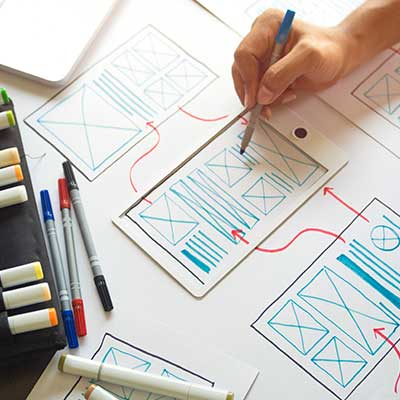Part 1: UX and SEO
What UX and SEO can learn from each other – An overview
Part 1: UX and SEO
What UX and SEO can learn from each other –
An overview
When developing a user experience for a web app, the question of optimization for search engines often arises. This is to ensure that the developed website is quickly found by the crawler bots of the search engines and thus is well ranked in the search results.
In UX & UI design, one is therefore not only faced with the task of developing a logical structure, optimal usability and an appealing visual appearance of the designed website, but also to incorporate the desired SEO guidelines of the search engines into the design work. Because nothing is more regrettable than a good website that looks great but is still not found by search engines.
First of all, it should be clarified briefly what is meant by the terms SEO and UX & UI design.
What is UX Design?
User Experience Design (UX) is concerned with the architecture of a product in general and deals with the question of how to plan the individual experience and the user experience of a product for a smooth flow. UX design thus focuses on the sense and value of an application. The inner logical structure of the app is then conceived.
The following tasks are summarized in UX Design:
UX Design takes care of the general architecture of a product.
What is search engine optimization (SEO)?
Search engines are the central point of contact for all users on the Internet to find relevant content quickly and easily. Search engine optimization (SEO) aims to optimize web apps and websites so that they are indexed and ranked as well as possible by search engines, making it easier for users to find content.
SEO comprises the following areas, each of which must be individually optimized:
SEO acts as a quality check and guide to a product.
What is UI design?
User Interface Design, on the other hand, deals with the planning of interaction and communication between man and machine. Thereby interactions are controlled via different interfaces. If not only digital but also analog interfaces are involved, this is called touchpoint design. In concrete terms, UI design is about developing an idea that has already been conceived from a UX perspective.
UI design can be further subdivided into the following fields of activity:
UI design represents the windows, doors and guidance systems within the architecture of a product.
And what is Visual Design?
While good UX and UI design helps to avoid a negative user experience when using a product, visual design translates the developed UX & UI design into an appealing graphical product. The transition between UI and visual design is often fluid.
Visual design is largely based on what was developed in UX & UI design. The design should already be based on the defined personas and target groups and be adapted to them linguistically and graphically.
Visual Design includes the following areas:
Visual design determines the appearance and thus influences the first impression of the user.
Good SEO and design always go hand in hand!
Every search engine follows guidelines and publishes recommendations on how a web app should be structured so that it can be evaluated as easily as possible by the respective search engine. Consequently, websites that follow these recommendations are ranked much higher than those that are not optimized.
For this reason, it is advisable to integrate SEO into the design process right from the start. Because the possibility that a product can be found is at least as important as the design of the product itself.
SEO requires great design – and vice versa.
Overlap of SEO and UX & UI design
In the center of interest of SEO and UX & UI design is the satisfaction of the user. If a user can quickly find the information he is looking for without major hurdles, both the search engine and the provider of the information or product have fulfilled their service.
The decisive overlap criteria are therefore as follows:
Overlap of SEO and Visual Design
SEO and visual design overlap in that users of a search engine naturally prefer to see results that convey content in an appealing and easily understandable way.
Thus, in search engine optimization in the field of visual design, care must also be taken to ensure sufficient color contrasts to enable people with visual impairments to use the website.
The following areas of SEO and visual design overlap:
Conclusion
The interaction of the experiences of users in the search for and use of a product should therefore not be neglected. If a website is perceived as appealing and user-friendly, visitors stay longer and consume more of the content. This behavior in turn is reflected in the search engine rankings. However, visitor behavior can only be positively evaluated by search engines if the site or application allows search robots to evaluate it optimally.
That is why it is so important that the user experience, application architecture and design take into account the rules and conditions of search engine optimization and implement them perfectly.
Can we support you? Contact our experts!
With WAVESTONE, you have a strong partner at your side.
We look forward to your challenge!



